“Praying Always” according to St Jane de Chantal
It was said of St. Jane de Chantal that “in every place she was in prayer”. She herself said “the great method of prayer is that there is none at all”. 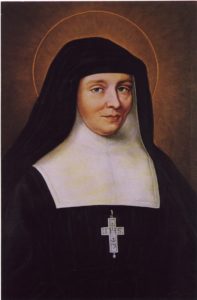 Yet much of her life was devoted to forming a community in which each sister was to be “a daughter of prayer”. How does this saint tell us her secret of praying everywhere and anywhere, any time and all the time?
Yet much of her life was devoted to forming a community in which each sister was to be “a daughter of prayer”. How does this saint tell us her secret of praying everywhere and anywhere, any time and all the time?
First of all, look at time itself. There doesn’t seem to be enough of it. It runs out. Some day, it actually will run out. You will literally be out of time. And this perspective could be a help to seeing your time here on earth for what it really is. Made out of love, made for heaven, God your Father put you on this earth here and now to complete your mission and in this way to give Him glory. His love created you for a purpose. Do you have the faith and courage to find out His plan and do His will for your short time on earth? Then pray, because ” alone you can do nothing”.
Holy Mother (St. Jane de Chantal) tells us that, in order to pray, we need to do our part. We must detach ourselves from earthly things.
“Accustom yourself to disregard many things, and to want very few of them, remitting all to the Providence of the Heavenly Father, who does not want the souls that He cherishes to place their hopes on the goods of the earth, but on the eternal ones which He prepares for them in His sweet mercy.”
Trusting in 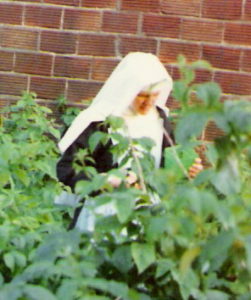 God means letting go of a lot of things we don’t need, including worry. Our belief in heaven and our place there changes everything. If we lack material things, we are promised heavenly ones. “Blessed are the poor in spirit, for the kingdom of heaven is theirs.” If we suffer, our sufferings, offered to God, become our Retirement Fund for heaven. God is our Father. He loves us. He cares for us. He has a plan for our lives. This trust, and real, active faith in our Father’s love is the beginning of prayer.
God means letting go of a lot of things we don’t need, including worry. Our belief in heaven and our place there changes everything. If we lack material things, we are promised heavenly ones. “Blessed are the poor in spirit, for the kingdom of heaven is theirs.” If we suffer, our sufferings, offered to God, become our Retirement Fund for heaven. God is our Father. He loves us. He cares for us. He has a plan for our lives. This trust, and real, active faith in our Father’s love is the beginning of prayer.
Now for the praying always. Holy Mother asks her daughters “why do we pray?” And she answers “to be united to God.” Then she adds, “How are we united to God?” Her answer “by doing His will.” So when we do His will we are praying. And this leads us to find Him everywhere. “If we seek God everywhere, we find Him everywhere.” (St. Jane de Chantal)
To pray always and to seek God always we open our spiritual eyes to see God’s loving gaze on us – and then,  open our spiritual ears to God’s Providence by listening to all He says to us through “that sweet voice of all creatures” – the cry of a newborn baby in the middle of the night, the bumble bee buzzing over a flower in a garden, the sunrise, the dog jumping on the couch, the hug of a child, the arm around your shoulder of a loving spouse, the grandchild’s smile, the minute before the anesthesia, the last farewell at a grave . . . God is there. He is right there with us. Our loving embrace of the present moment, His gift to us, is our way of praying always.
open our spiritual ears to God’s Providence by listening to all He says to us through “that sweet voice of all creatures” – the cry of a newborn baby in the middle of the night, the bumble bee buzzing over a flower in a garden, the sunrise, the dog jumping on the couch, the hug of a child, the arm around your shoulder of a loving spouse, the grandchild’s smile, the minute before the anesthesia, the last farewell at a grave . . . God is there. He is right there with us. Our loving embrace of the present moment, His gift to us, is our way of praying always.
Silver Jubilee of our dear Sister Mary Aloysia
On May 1st our dear Sister Mary Aloysia, who is 90 years young, celebrated her Silver Jubilee of Religious Profession. We share with you her vocation story as told to one of our sisters some time ago. Pictured is our dear Sister before Mass and enjoying the company of her great, great nephew in the parlor after Mass.
“Through the Narrow Gate”
Vocation Story of our dear Sister Mary Aloysia as told by herself
I lived in Detroit, Michigan with my mother and father and my older sister, Betty. Dad worked for the DPW, Detroit Public Works – at the dump. He worked himself to death there We were poor, but dad still did good deeds – like visiting his uncles Jack and John in Shipkey, Canada. Mom worked for Burroughs Automative. She kept the books. Dad said she was the best bookkeeper they ever had. Mom’s mom had died when she was 8 years old of a brain hemorrhage, and her dad died of the same thing when he fell off a ladder. Mom was 14 years old at the time. We we re poor. Every Christmas our “Rotary Uncles” brought us a Christmas box – with a present for everyone. And in the summer, they hired out the Put-in-Bay boat and we went for a ride down the Detroit River and had a picnic lunch. I’ll never forget them. They were so good to us.
re poor. Every Christmas our “Rotary Uncles” brought us a Christmas box – with a present for everyone. And in the summer, they hired out the Put-in-Bay boat and we went for a ride down the Detroit River and had a picnic lunch. I’ll never forget them. They were so good to us.
I wasn’t always handicapped. When I was three years old, I cut my head. Mom and dad took me to Hyland Park General Hospital. They said I had blood poisoning and scarlet fever. The Good Lord got me through. After 52 days, they said they couldn’t do anything more for me and sent me home. Mom made me fried potatoes. She was a good cook and made big, fluffy dumplings. She made me fried potatoes, and that brought me back. I always loved fried potatoes after that, but we don’t get them much here. From that time on, I had dislocated bones and I couldn’t walk easily. Blood poisoning and scarlet fever, that’s what they always said it was. I went to a wonderful school for the handicapped, Charles Oakmann School. When I was sixteen years old, dad fixed up a bike for me, a twenty-six incher. He fixed bicycles. I taught myself to ride it on a walkway next to the house. I scraped up my two fingers pretty badly from holding on to the handlebars and bumping into the house. But I learned to ride.
I finished my schooling at Cooley High School. My sister Betty got married to Ken and I went to work. One night when I got home from work my dad was sitting in the arm chair. “Where’s mom and sis?” I asked. “They went to the hospital.” Sis was going down to the cellar when the latch broke and she tripped. She went into labor, and the baby was premature. That was my sister’s first child. The baby’s name was Colleen. Dad loved that baby. She had the biggest blue eyes and the sweetest smile. And sis would put a big bonnet on her. She was so cute with her diaper and big bonnet. Dad died on May 2, 1950 of exhaustion. He wasn’t practicing his faith, but the priest who came to see him on the night he died said he never heard such a good confession.
I had a couple of offers of marriage, but they fell through. Then I went on a retreat at Mt. Mary, where the Sisters of Mary Reparatrix had their convent. After my retreat, Mother Mary of St. Mildred became a good friend of mine. I talked to her about becoming a religious, but due to my handicap, I didn’t know who would accept me. She said, “I know where you can go.” And she told me where the Sisters of the Visitation were located – Toledo, Ohio. After a couple of years, I contacted them and I talked to Mother Francis de Sales Cassidy who was very kind and encouraged me to come and I did in 1952. I loved everything about the monastery. It was a holy place. Everything was so beautiful. Then my health broke and the doctor said it was too hard for me. Mother said I would have to leave. I didn’t want to go away, but I had to.
to her about becoming a religious, but due to my handicap, I didn’t know who would accept me. She said, “I know where you can go.” And she told me where the Sisters of the Visitation were located – Toledo, Ohio. After a couple of years, I contacted them and I talked to Mother Francis de Sales Cassidy who was very kind and encouraged me to come and I did in 1952. I loved everything about the monastery. It was a holy place. Everything was so beautiful. Then my health broke and the doctor said it was too hard for me. Mother said I would have to leave. I didn’t want to go away, but I had to.
I went back home. Mom was sick and, not too long after that, my sister got Parkinson’s Disease – that’s a terrible illness. I got a job as the secretary and bookkeeper at St. Colman’s and I helped out at home with mom and Betty and my little nieces. For 20 years I was the secretary at the rectory. They had the cutest dog there, a miniature schnauzer named Linus. One time he ate all the candy. You should have seen the mess! After that, we had to lock him up when Father’s housekeeper and I weren’t there to watch him. Then they got computers, and I didn’t think I could do that, so I retired. I had a couple of job offers, but I had been corresponding with Sister Mary Theresa and she thought I might try again at the Visitation. Mother Mary Bernard said I would have to come on a retreat. “That won’t be hard,” I said. So I came and I reentered. I’ve been here 24 years. And on February 28th, I’ll be ninety years old. Thirty-fours years away from the monastery and twenty-four back in.
The Original Plan as told in “Mission and Spirit”
In this Year of Consecrated Life, we continue the account of our foundation as told in our “Mission and Spirit.”
The Original Plan (from “Mission and Spirit”)
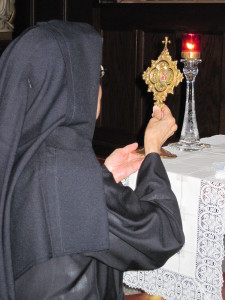 Why this foundation? St Francis de Sales has often himself explained it: “The plan is to give God Daughters of prayer, and souls so interior, that they may be found worthy to serve His Infinite majesty and to adore Him in spirit and in truth. The great Orders already established in the Church may be left to honor our Lord by excellent spiritual exercises and striking virtues, but all I want for my Daughters is that they should try to glorify Him by their lowliness; . . .”
Why this foundation? St Francis de Sales has often himself explained it: “The plan is to give God Daughters of prayer, and souls so interior, that they may be found worthy to serve His Infinite majesty and to adore Him in spirit and in truth. The great Orders already established in the Church may be left to honor our Lord by excellent spiritual exercises and striking virtues, but all I want for my Daughters is that they should try to glorify Him by their lowliness; . . .”
“. . . so as to follow Our Lord more readily, more freely and more favorably , hearing the voice of the One who calls them to follow, they leave all things, like the Apostles, clinging to one thing only – to please God and follow Him , not wanting their heart to be divided and distracted by many different things, but simply and whole-heartedly to seek the unity of a sole and single minded love of God”.
There will be no solemn vows in this little assembly but very great inner perfection. (This would change with the first foundation made in Moulins after which the congregation was 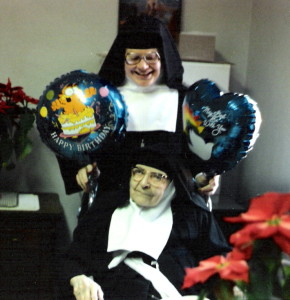 erected into a regular Order with solemn vows and papal enclosure.)
erected into a regular Order with solemn vows and papal enclosure.)
“. . . as this Congregation will not have great austerity, nor yet bonds from which the Sisters cannot be released, as is the case of formal or regular Congregations, the fervor of charity and the force of a very firmly held inner determination must supply for all that, and take the place of laws, vows and jurisdiction, so that this Congregation may demonstrate the truth of the Apostle’s words, that the bond of charity is the bond of perfection”.
From 1st July 1610, St. Francis wanted his little Congregation to be called: The Visitation of Our Lady, or Religious of the Visitation of Holy Mary, “because”, as he said , “he found in it very many spiritual facets which filled his mind with special light about the spirit he wanted to establish in his Institute”.
“. . . because it was a hidden mystery and was not given solemn celebration in the Church as were others, it would at least be given a special place in our Congregation”.
According to his particular genius, which was firmly to leave beaten tracks and to keep his eye only on essentials, St. Francis de Sales was trying out an experiment of the kind which made him publish The Introduction to the Devout Life. After he had put a deeply Christian life within the reach of all, he opened up the doors of an authentic religious life to every soul called to it by God:
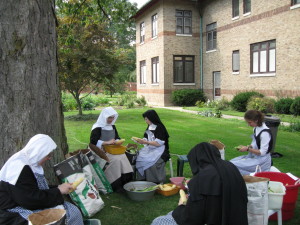 “It often happens that girls and women with a true vocation want to enter religious life , but either because of their health or their age, or simply because they are not drawn to austerities and external rigor, find that they cannot enter orders where considerable physical penance is the rule . . .”. And so that souls of this kind should in future find some assured retreat in this part of the country, our Congregation has been designed in such a way that no great rigor should prevent those who are not strong and robust from joining it and pursuing the perfection of divine love”.
“It often happens that girls and women with a true vocation want to enter religious life , but either because of their health or their age, or simply because they are not drawn to austerities and external rigor, find that they cannot enter orders where considerable physical penance is the rule . . .”. And so that souls of this kind should in future find some assured retreat in this part of the country, our Congregation has been designed in such a way that no great rigor should prevent those who are not strong and robust from joining it and pursuing the perfection of divine love”.
“Two things are needed if women of this kind are to be given a positive vote: firstly, they must be people really called by God ; secondly, they must have the conditions laid down for our manner of life . . . A good vocation is, in fact, a firm and steady will on the part of the person called , that she wants to serve God in the manner and in the place to which His divine Majesty is calling her”.
This is how Father de Villars, SJ. expresses his approbation when writing to the Founder: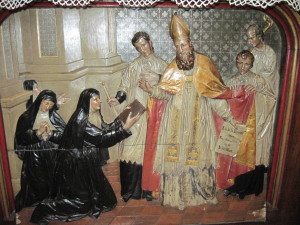
“It seems to me, Monseigneur, that there is still a definite need in the Church for this Congregation and that God has raised you up in our day to make this foundation. Our Lord has indeed visited his people, and it looks as though the blessing of this beginning will extend ever more widely with a great increase in numbers: for surely , the less robust needed a middle way, widows a moderate approach, and the hardy and fervent can well do with this kind of mortification”.